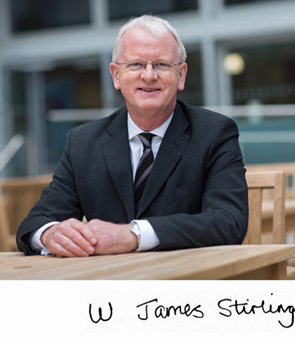James Stirling (physicist) facts for kids
Quick facts for kids
James Stirling
|
|
|---|---|
 |
|
| Born | 4 February 1953 |
| Died | 9 November 2018 (aged 65) |
| Alma mater | Peterhouse, Cambridge University |
| Awards | Smith's Prize (1978) |
| Scientific career | |
| Institutions | Durham University CERN Cambridge University University of Washington |
| Thesis | Deep Inelastic Processes in Asymptotically Free Theories (1979) |
| Doctoral advisor | John Polkinghorne |
William James Stirling (born February 4, 1953 – died November 9, 2018) was a brilliant physicist. He was the first person to hold the important job of Provost of Imperial College London. This role is like being a top leader at a major university. He started this job in August 2013 and finished in August 2018.
Contents
About James Stirling
Early Life and Education
James Stirling was born in Belfast in 1953. He grew up in Glengormley, County Antrim. He went to Glengormley Primary School and then Belfast Royal Academy.
In 1972, he started studying at Peterhouse, Cambridge University. He did very well in his math courses. He earned his first degree in 1975. After that, he continued his studies at Peterhouse. He earned his PhD (a very high degree) in 1979. His PhD was in Theoretical Particle Physics. In 1978, he won a special award called the Smith's Prize for Mathematics.
His Career in Physics
After finishing his studies, James Stirling worked as a researcher in the United States. He also worked at Cambridge University and at CERN in Geneva, Switzerland. CERN is a huge science lab where physicists study tiny particles.
In 1986, he became a lecturer at Durham University. In 2000, he became the first Director of a new center there. This center was called the Institute for Particle Physics Phenomenology (IPPP). It studies how tiny particles behave. Before moving back to Cambridge, he was in charge of research at Durham University from 2005 to 2008.
At Cambridge, he became the Jacksonian Professor of Natural Philosophy. This is a very old and respected teaching position. He was also the head of the Cavendish Laboratory. This lab is famous for many important discoveries in physics. He was also a Fellow at Peterhouse at the University of Cambridge.
From 2001 to 2003, he led a science committee for the Particle Physics and Astronomy Research Council. This group gave advice on important science projects. He also helped review physics research in 2001 and 2008.
His Research Work
James Stirling's main area of study was theoretical particle physics. This field tries to understand the smallest parts of matter and how they interact. Over more than 30 years, he wrote over 300 research papers. Many of his papers are still used and referenced by other scientists today.
He was especially interested in particle physics phenomenology. This is where theory meets experiments. He worked closely with scientists who did experiments in labs in Europe and the United States. He was part of a famous group called the MSTW collaboration. This group studied the inside structure of the proton, which is a tiny part of an atom.
Awards and Recognition
Because of his important work in particle physics, James Stirling became a Fellow of the Royal Society in 1999. This is a very high honor for scientists in the UK.
In 2006, he was given the title of CBE. This award was for his great contributions to science. He was also a member of the Council of the Royal Society from 2007 to 2008. From 2009, he served on the Council of the Science and Technology Facilities Council (STFC).
Since 2008, the IPPP in Durham has held an annual public talk called the Stirling Lecture. This lecture is named in his honor.

